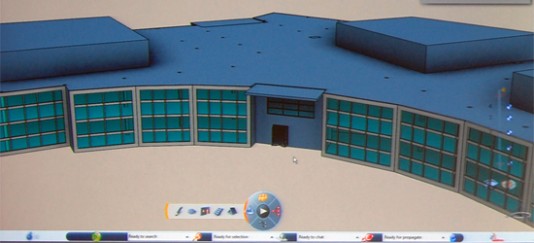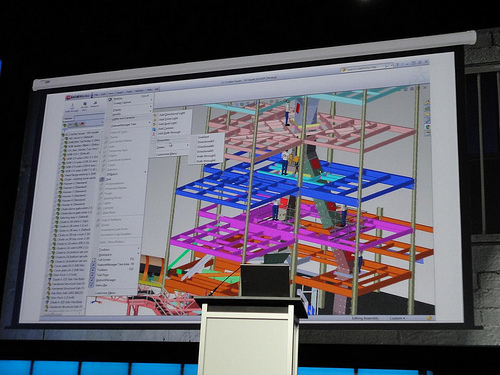Dassault Systèmes is committed to building a next-generation 3D design platform to replace SolidWorks. Getting it out the door is proving hard; convincing SolidWorks customers to upgrade will be harder.
By Randall S. Newton
 On the final day of SolidWorks World 2010 in Anaheim, then-CEO Jeff Ray gave a preview of major changes coming to the SolidWorks product line. He often used the phrase “SolidWorks V6” and talked about the robust Enovia data management technology that would be the foundation of a variety of new products and services for the next generation. A year later at SolidWorks World 2011 in San Antonio the press was given a brief presentation of a new SolidWorks-branded product called Live Buildings, design software for construction based on Dassault Systèmes’ V6 technology as used in Catia, 3D Via and other products.
On the final day of SolidWorks World 2010 in Anaheim, then-CEO Jeff Ray gave a preview of major changes coming to the SolidWorks product line. He often used the phrase “SolidWorks V6” and talked about the robust Enovia data management technology that would be the foundation of a variety of new products and services for the next generation. A year later at SolidWorks World 2011 in San Antonio the press was given a brief presentation of a new SolidWorks-branded product called Live Buildings, design software for construction based on Dassault Systèmes’ V6 technology as used in Catia, 3D Via and other products.
Fast forward to SolidWorks World 2012, held last week in San Diego. Current CEO Bertrand Sicot announced on the first day that, for the second year in a row, there would be no news about a “next generation CAD platform” at this year’s event. He promised SolidWorks 2013 (to be released later this year) “will be supported as long as our users require it.” Live Buildings was only discussed with individual members of the press who agreed to not write about their discussions immediately. Comparing the two events, it seems as if Sicot is trying to un-ring the bell Ray struck in 2010 and 2011.
In the press lounge between meetings, reporters and analysts shared with each other conversations with users and employees. Two points of general consensus emerged:
- SolidWorks users were disappointed by the lack of news about the next generation, but still expected the company would do right by their beloved 3D design software;
- Employees were tight-lipped, but there was a pattern emerging that things were not going well with the “SolidWorks V6” project. As usual with gathering unpleasant corporate news, the journalists who learned the most were the ones willing to spend late hours in the bars.

Meet the press
In two separate press conferences company executives were asked for more information about the future of SolidWorks. On Monday new VP of R&D Gian Paolo Bassi sought to identify in broad terms the future of SolidWorks. He spoke of “the rigidity of parametric-based CAD” and the need for a better approach to direct editing than what is currently offered by SolidWorks’ competitors. The real problem, Bassi said, is not to be able to push and pull but to introduce more flexibility into topology while enforcing design intent. He said mobile CAD technology is interesting, but that the industry is currently experimenting; when Dassault presents mobile technology “it will be consistent across all platforms.” (For more on Bassi’s thoughts about the future of SolidWorks, see the GraphicSpeak article, “New SolidWorks R&D VP Bassi will be under the microscope at SolidWorks World 2012.”
On Wednesday several executives met with the press, but SolidWorks old timer Fielder Hiss, now VP of Product Management, did most of the talking. “The challenge is huge and the burden is huge,” he said, referring to the transition of today’s SolidWorks to the next generation based on V6. “We are building a platform for the next 20 years,” a reminder of Monday’s opening session homage to 20 years of SolidWorks. “Managing expectations is hard,” explaining that Dassault wants the new platform to solve problems and not come across as the tool of the past in a new skin.
Hiss described the intellectual property available from Dassault as “a war chest,” a huge trove of products and technologies. “Why would we not want to use it? … We want to create the next generation of technology using everything available to us.” At the same time he commented on the industry perception that Dassault Systèmes follows a “closed” product philosophy while SolidWorks is noted for being “open.” “In our market we must fundamentally be open,” Hiss said. “I wouldn’t say there is a clash [between SolidWorks and the rest of Dassault.] We are all evolving, but if the SolidWorks brand becomes a closed philosophy, we are dead.”
The 3D kernel at the heart of today’s SolidWorks is Parasolid, a technology owned by Siemens PLM Software. It is also the 3D kernel for Siemens PLM’s NX and SolidEdge, Bentley MicroStation, Nemetschek Vectorworks, and several other CAD products. When asked why SolidWorks would move from Parasolid to CGM, the 3D kernel inside Dassault’s Catia, Bassi strongly defended the move. “[Dassault] owns every single line of code. This opens up huge possibilities, ones you can’t match with buying components. We have a fantastic toolbox of technologies and people to draw from. We want to create the next generation of technology using everything available to us.”

Legacy status, Dassault style
Without making a formal announcement, Dassault Systèmes has made clear the SolidWorks of today is a legacy product, software with a past but not much of a future. The 2013 version will be tweaked around the edges, with such new features as increased options for assembly visualization, revision clouds (drafting notation clouds, not distant servers), multiple exploded views, and “previous release interoperability.” But it will most likely be the last release of SolidWorks using the Parasolid 3D kernel.
What does this mean to today’s SolidWorks users? In the short run, not much. Statements from company executives that they will support today’s SolidWorks should be taken at face value. Look at the thousands of seats of Catia V4 and V5 still supported by Dassault as an example of the company’s commitment to its users. Supported, but not upgraded with new features. Any company that wants to use today’s SolidWorks for the next five years will have clear sailing and all the support they need.
Support is one thing, innovation is another. And that’s where the idea of SolidWorks as legacy software gets interesting. More than 10 years ago Autodesk started pushing 3D as the way of the future and did everything it could to convince AutoCAD users to move on. It bundled Revit (AEC) or Inventor (mechanical) with its industry-specific versions of AutoCAD. The result? Today Revit and Inventor are strong products with healthy sales, but AutoCAD still accounts for about one-third of company revenue, about $650 million in 2011. Every year Autodesk adds new features to AutoCAD, including its 3D capabilities.
SolidWorks contributes 20% of Dassault Systèmes annual revenue, with higher profit margins than any other DS division. There is no way Dassault will shoot the golden goose in the name of progress. Three or four years from now Dassault may well be forced by its users to continue to add new features to “legacy” SolidWorks.





